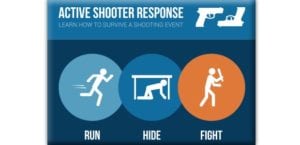Active Shooters and Police Response

By Officer Tim Mitten
Community Action Officer
Phoenix Police Department
Black Mountain Precinct
In the history of the world there have been many examples of the brutality of man and indifference to human life. Today’s plethora of mass shootings is one of modern society’s biggest issues facing the United States. This article will not be a pro or con argument about the Second Amendment or, about the status of mental health in the United States. I will describe a brief history of mass shootings; what steps can be taken to reduce the chances of becoming a causality and what you can expect from law enforcement upon arrival.
The FBI defines mass murder as, “at least one aggressor that kills at least four people in a twenty-four hour period.” The idea or incidents of mass shootings is not new as one of the first was in Germany in 1913 when a subject killed his wife and four children and then opened fire on twenty more, killing nine of them. In the United States between 1920 and 1960, most mass murders or shootings were familicides, meaning it was isolated to one particular family and not the general public. After 1960, the trend started to have these incidents occur in public places and against unknown bystanders.
Some of the earliest mass incidents were: San Ysidro, CA at McDonalds in 1984 where twenty-two were killed, US Post Office in 1986 where fifteen were killed, and a Luby’s restaurant in 1991 where twenty-four were killed. Then what is generally used as a benchmark for the media coverage of modern day and where many law enforcement agencies changed their strategies upon arrival was Columbine High School in 1999 where fifteen people were killed. Then some of the more horrific incidents, Pennsylvania Amish School, Virginia Tech, Fort Hood, Aurora Theater, San Bernardino Center, Orlando night club, Dallas Police, Las Vegas music festival, Parkland and so on. I only bring these incidents up for the sole reason to show the variety of locations, that there is no common victimology and that there are many profiles the shooter may have. It can happen anywhere, at any time and we as law enforcement are constantly working to identify potential suspects and working with businesses and communities alike to target harden locations.
There are things that people in businesses, communities and as a family can do if found in an active shooting situation. The Department of Homeland Security has a short video called “Run, Hide, Fight” which covers the concepts I am about to discuss.
Run:
• Have an escape plan by knowing where the exits are
• Leave your belongings
• Evacuate regardless of whether others follow
• Help others escape if possible
• Do not attempt to move the wounded.
• Prevent others from entering the area
• Keep hands visible when contacted by police
Hide:
• If you can’t exit the building then find a place to hide
• Should be out of sight of the shooter
• Making it cover over concealment is better
• You want where you hide to not trap you
• Lock the door to prevent the shooter from entering
• Call 911 when possible
• Make sure you are as safe as can be when you call
• If the shooter gets close don’t try to whisper
• Leave the line open so dispatch can hear
Fight:
• As a last resort and only when your life is in imminent danger.
• Attempt to disrupt and/or incapacitate the shooter
• Be as aggressive as possible
• Throw items to distract
• Be committed to your actions
• Consider Improvised Weapons
– Fire Extinguisher
– Scissors
– Stapler
– Chair
– Pen
– Heavy objects
It is also important for people to know what law enforcement will do upon arrival at an active shooting situation. The Phoenix Police Department reevaluated our responses after the Columbine incident to come up with a more dynamic response which we call ASI or Active Shooter Intervention. The first and primary goal upon officer’s arrival is to stop the violence and the loss of life from continuing and this is to be done as quickly as possible. Officers will go direct to threat, bypassing wounded individuals to actively find and stop the threat. This concept seems difficult for some to comprehend but it is the quickest and safest way to stop the loss of life from continuing. Once that threat is stopped then officers will aid in the treatment and evacuation of the injured and direct medical rescue personnel in.
If you are inside an active shooting situation and you see officers arriving, it is very important that you try to remain calm and not yell or scream at the officers. Follow the officer’s instructions, keep your hands visible at all times with nothing in them and be prepared to be searched. Do not grab onto the officers and go exactly where they tell you to go without stopping. You will be interviewed at some point and even the responding officers may ask you questions, only state what you know or saw yourself, not what you heard from someone else. If prior to the officers arriving you called 911, be as descriptive as you can as to number of shooters, description of the shooter, location, number of victims, and if you know the type of weapons. Do not guess, again only tell what you know for sure as the rate of information coming in is vast and law enforcement needs accurate information.
I truly hope and pray that none of you are ever faced with this situation but be secure in the knowledge that the Phoenix Police Department is well trained and ready to respond if needed.
Please review this information with your coworkers, friends and family so that everyone can be on the same page. If I can be of further assistance, please feel free to contact me at 602-495-5238 or at tim.mitten@phoenix.gov.
Thanks again for being involved in your community and partnering with the Phoenix Police Department to help improve the quality of life and safety of your neighborhood.









